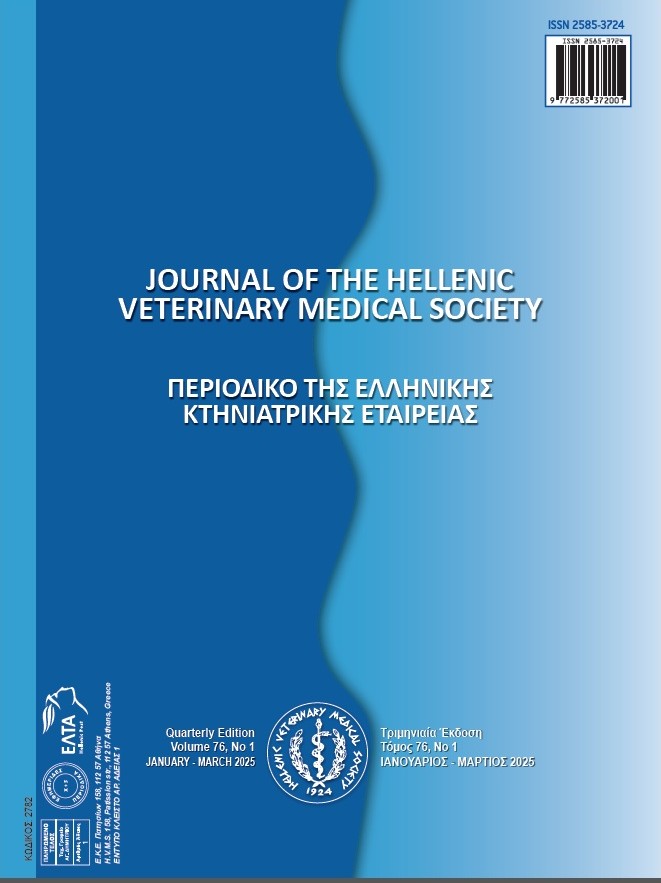Γενετική παραλλακτικότητα και απλοτύποι του Echinococcus equinus σε γάιδαρο στην Τουρκία
Περίληψη
Η κυστική εχινοκοκκίαση (CE) είναι μια παρασιτική ζωονόσος που προκαλείται από την προνύμφη Echinococcus granulosus sensu lato. Η παρούσα μελέτη διεξήχθη για τον μοριακό χαρακτηρισμό των κύστεων CE που ελήφθησαν από έναν γάιδαρο που είχε μολυνθεί φυσικά με κύστεις CE και για τον προσδιορισμό της ποικιλομορφίας των απλοτύπων. Διερευνήθηκαν δέκα μεμονωμένες κύστεις CE που εντοπίστηκαν στο ήπαρ ενός γαϊδάρου. Το γονιδιωματικό DNA εξήχθη από κάθε μεμονωμένη απομόνωση κύστης. Προϊόν PCR τμήματος 875 bp του μιτοχονδριακού γονιδίου της υπομονάδας 1 της κυτοχρωμικής οξειδάσης c (mt-CO1) ενισχύθηκε με τη χρήση ειδικών εκκινητών. Τα προϊόντα PCR καθαρίστηκαν και πραγματοποιήθηκε ανάλυση της αλληλουχίας. Οι μερικές αλληλουχίες του γονιδίου mt-CO1 που ανήκουν στις απομονώσεις της κύστης CE συγκρίθηκαν με τις δημοσιευμένες αλληλουχίες αναφοράς. Οι μερικές αλληλουχίες του mt-CO1 ταυτοποιήθηκαν ως E. equinus. Μετά από ανάλυση απλοτύπων, ταυτοποιήθηκαν δύο διαφορετικοί απλότυποι (Hap01 και Hap02). Εννέα αλληλουχίες που προέκυψαν από την παρούσα μελέτη ανήκαν στον κύριο απλότυπο (Hap01)- ωστόσο, μια άλλη αλληλουχία γαϊδούρας από την παρούσα μελέτη εντοπίστηκε στον Hap02 με νουκλεοτιδική διαφορά. Παρόλο που ο Echinococcus granulosus s.s. (G1 και G3) αναφέρεται ότι είναι το κυρίαρχο είδος και τα τρέχοντα ευρήματα έδειξαν ότι ο E. equinus (G4) και οι απλότυποι του θα μπορούσαν επίσης να κυκλοφορούν σε γαϊδούρια από την Τουρκία.
Λεπτομέρειες άρθρου
- Πώς να δημιουργήσετε Αναφορές
-
Kilinc, S., Celik, F., Kesik, H., & Simsek, S. (2025). Γενετική παραλλακτικότητα και απλοτύποι του Echinococcus equinus σε γάιδαρο στην Τουρκία. Περιοδικό της Ελληνικής Κτηνιατρικής Εταιρείας, 76(1), 8689–8696. https://doi.org/10.12681/jhvms.37134
- Τεύχος
- Τόμ. 76 Αρ. 1 (2025)
- Ενότητα
- Research Articles

Αυτή η εργασία είναι αδειοδοτημένη υπό το CC Αναφορά Δημιουργού – Μη Εμπορική Χρήση 4.0.
Οι συγγραφείς των άρθρων που δημοσιεύονται στο περιοδικό διατηρούν τα δικαιώματα πνευματικής ιδιοκτησίας επί των άρθρων τους, δίνοντας στο περιοδικό το δικαίωμα της πρώτης δημοσίευσης.
Άρθρα που δημοσιεύονται στο περιοδικό διατίθενται με άδεια Creative Commons 4.0 Non Commercial και σύμφωνα με την άδεια μπορούν να χρησιμοποιούνται ελεύθερα, με αναφορά στο/στη συγγραφέα και στην πρώτη δημοσίευση για μη κερδοσκοπικούς σκοπούς.
Οι συγγραφείς μπορούν να καταθέσουν το άρθρο σε ιδρυματικό ή άλλο αποθετήριο ή/και να το δημοσιεύσουν σε άλλη έκδοση, με υποχρεωτική την αναφορά πρώτης δημοσίευσης στο J Hellenic Vet Med Soc
Οι συγγραφείς ενθαρρύνονται να καταθέσουν σε αποθετήριο ή να δημοσιεύσουν την εργασία τους στο διαδίκτυο πριν ή κατά τη διαδικασία υποβολής και αξιολόγησής της.



